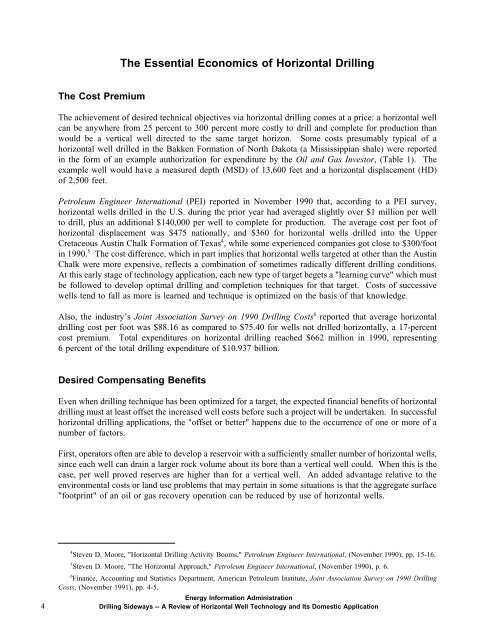Drilling Sideways -- A Review of Horizontal Well Technology ... - EIA
Drilling Sideways -- A Review of Horizontal Well Technology ... - EIA
Drilling Sideways -- A Review of Horizontal Well Technology ... - EIA
You also want an ePaper? Increase the reach of your titles
YUMPU automatically turns print PDFs into web optimized ePapers that Google loves.
The Cost Premium<br />
The Essential Economics <strong>of</strong> <strong>Horizontal</strong> <strong>Drilling</strong><br />
The achievement <strong>of</strong> desired technical objectives via horizontal drilling comes at a price: a horizontal well<br />
can be anywhere from 25 percent to 300 percent more costly to drill and complete for production than<br />
would be a vertical well directed to the same target horizon. Some costs presumably typical <strong>of</strong> a<br />
horizontal well drilled in the Bakken Formation <strong>of</strong> North Dakota (a Mississippian shale) were reported<br />
in the form <strong>of</strong> an example authorization for expenditure by the Oil and Gas Investor, (Table 1). The<br />
example well would have a measured depth (MSD) <strong>of</strong> 13,600 feet and a horizontal displacement (HD)<br />
<strong>of</strong> 2,500 feet.<br />
Petroleum Engineer International (PEI) reported in November 1990 that, according to a PEI survey,<br />
horizontal wells drilled in the U.S. during the prior year had averaged slightly over $1 million per well<br />
to drill, plus an additional $140,000 per well to complete for production. The average cost per foot <strong>of</strong><br />
horizontal displacement was $475 nationally, and $360 for horizontal wells drilled into the Upper<br />
Cretaceous Austin Chalk Formation <strong>of</strong> Texas 4 , while some experienced companies got close to $300/foot<br />
in 1990. 5 The cost difference, which in part implies that horizontal wells targeted at other than the Austin<br />
Chalk were more expensive, reflects a combination <strong>of</strong> sometimes radically different drilling conditions.<br />
At this early stage <strong>of</strong> technology application, each new type <strong>of</strong> target begets a "learning curve" which must<br />
be followed to develop optimal drilling and completion techniques for that target. Costs <strong>of</strong> successive<br />
wells tend to fall as more is learned and technique is optimized on the basis <strong>of</strong> that knowledge.<br />
Also, the industry’s Joint Association Survey on 1990 <strong>Drilling</strong> Costs 6 reported that average horizontal<br />
drilling cost per foot was $88.16 as compared to $75.40 for wells not drilled horizontally, a 17-percent<br />
cost premium. Total expenditures on horizontal drilling reached $662 million in 1990, representing<br />
6 percent <strong>of</strong> the total drilling expenditure <strong>of</strong> $10.937 billion.<br />
Desired Compensating Benefits<br />
Even when drilling technique has been optimized for a target, the expected financial benefits <strong>of</strong> horizontal<br />
drilling must at least <strong>of</strong>fset the increased well costs before such a project will be undertaken. In successful<br />
horizontal drilling applications, the "<strong>of</strong>fset or better" happens due to the occurrence <strong>of</strong> one or more <strong>of</strong> a<br />
number <strong>of</strong> factors.<br />
First, operators <strong>of</strong>ten are able to develop a reservoir with a sufficiently smaller number <strong>of</strong> horizontal wells,<br />
since each well can drain a larger rock volume about its bore than a vertical well could. When this is the<br />
case, per well proved reserves are higher than for a vertical well. An added advantage relative to the<br />
environmental costs or land use problems that may pertain in some situations is that the aggregate surface<br />
"footprint" <strong>of</strong> an oil or gas recovery operation can be reduced by use <strong>of</strong> horizontal wells.<br />
4 Steven D. Moore, "<strong>Horizontal</strong> <strong>Drilling</strong> Activity Booms," Petroleum Engineer International, (November 1990), pp. 15-16.<br />
5 Steven D. Moore, "The <strong>Horizontal</strong> Approach," Petroleum Engineer International, (November 1990), p. 6.<br />
6<br />
Finance, Accounting and Statistics Department, American Petroleum Institute, Joint Association Survey on 1990 <strong>Drilling</strong><br />
Costs, (November 1991), pp. 4-5.<br />
Energy Information Administration<br />
4 <strong>Drilling</strong> <strong>Sideways</strong> -- A <strong>Review</strong> <strong>of</strong> <strong>Horizontal</strong> <strong>Well</strong> <strong>Technology</strong> and Its Domestic Application

















